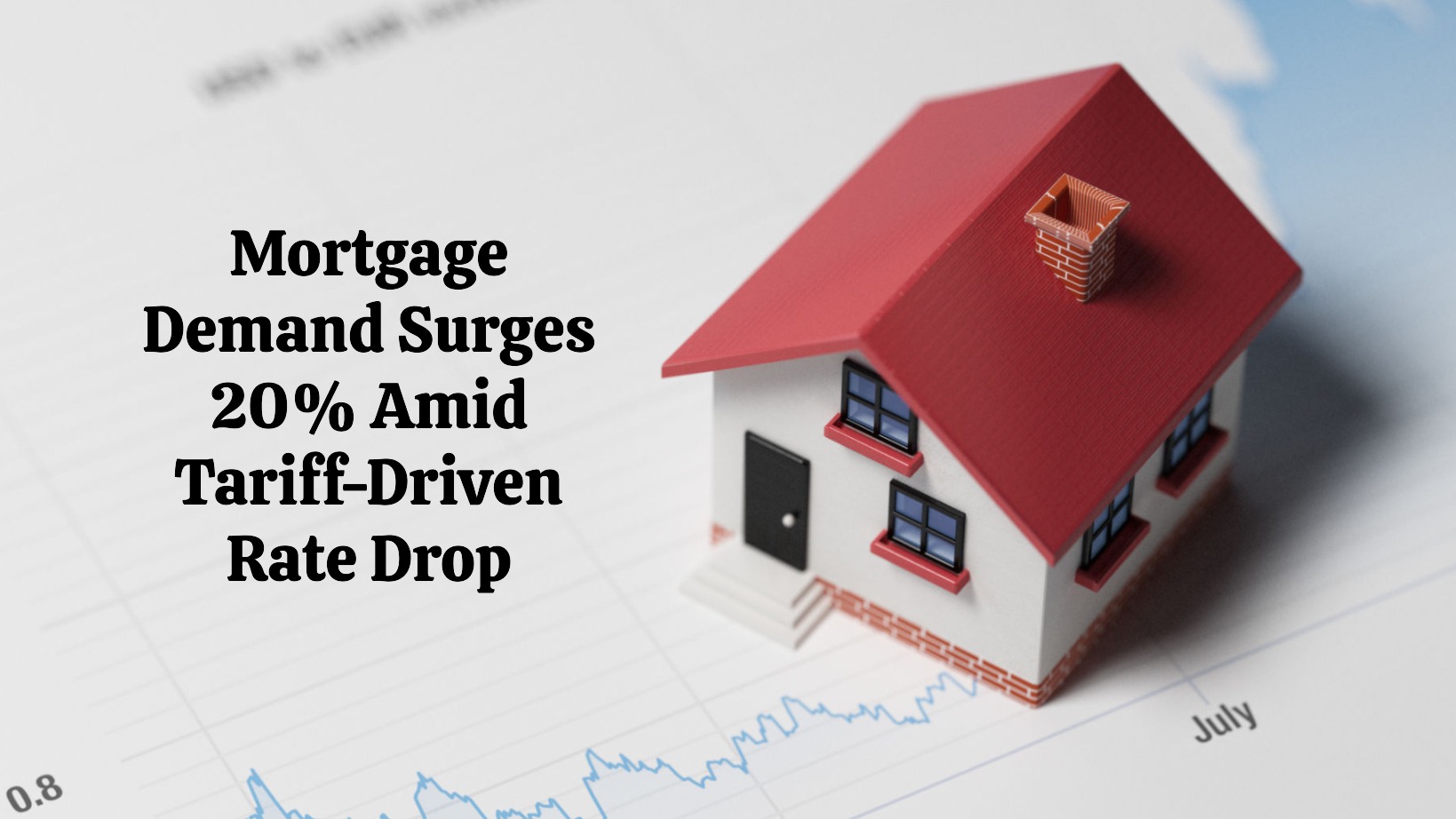If you've been on the fence about buying a home or refinancing your mortgage, recent events might have caught your eye. Last week, we saw a significant jump: Mortgage demand surged by 20%, reaching levels not seen since September 2024. This spike was triggered by a brief dip in mortgage rates, a consequence of volatility in the financial markets spurred by tariff-related news. Let's dive into what happened and what it means for you.
Mortgage Rates Drop: Demand Surges 20% Amid Tariff-Driven Turmoil
A Perfect Storm: Tariffs, Rates, and Refinancing
It all started with shifts in the tariff situation, which caused ripples in the financial markets. These ripples translated into a decrease in mortgage interest rates. The average contract interest rate for 30-year fixed-rate mortgages (with conforming loan balances of $806,500 or less) fell from 6.70% to 6.61%. While this might seem like a small change, it was enough to trigger a significant response from homeowners and potential buyers.
Think of it this way: even a slight dip in interest rates can save you a substantial amount of money over the life of a mortgage. For example, consider a $300,000 mortgage. Dropping your interest rate from 7% to 6.61% can save you almost $25,000 over 30 years. This is why the phones at mortgage lenders suddenly started ringing off the hook.
Key Factors Contributing to the Surge:
- Rate Drop: The decrease in mortgage rates, albeit brief, made borrowing more attractive.
- Refinancing Rush: Homeowners who had previously missed out on lower rates jumped at the opportunity to refinance. Applications to refinance a home loan increased 35% from the previous week and were 93% higher than the same week one year ago.
- Purchase Demand Increase: Applications for a mortgage to purchase a home increased 9% for the week and were 24% higher than the same week one year ago.
Refinance Applications Boom
The most significant reaction was in the refinance market. The 35% jump in refinance applications tells us that many homeowners have been waiting for the right moment to lower their monthly payments. The average refinance loan size also rose to its second highest in the survey at $399,600, indicating that a good portion of this demand came from borrowers with larger loans.
Purchase Demand Shows Strength
It wasn't just refinancing that saw a boost. Applications for mortgages to purchase homes also increased by 9% for the week, reaching their highest level since January 2024. This suggests that despite higher prices, the underlying demand for homeownership remains strong. It's also a sign that some buyers are getting used to the current rate environment and are ready to move forward with their plans.
Adjustable-Rate Mortgages (ARMs) on the Rise
Interestingly, the share of adjustable-rate mortgage (ARM) applications also climbed last week, reaching 8.6% of total applications, up from 5.4% the previous week. This could be because the average contract interest rate for 5/1 ARMs decreased to 5.93% from 6.04%. Crossing into that emotionally significant 5% range might be more appealing to some buyers.
Will the Good Times Last?
The surge in mortgage demand was certainly exciting, but it's important to consider whether it will last. Unfortunately, the initial data suggests this party may be over already.
Rates have already started climbing again. A separate survey from Mortgage News Daily indicated that rates rose sharply at the beginning of this week, effectively wiping out all of last week’s gains and then some. It appears as though that tariff volatility is not to be relied upon to bring down mortgage rates and that rates may be on the rise as we head into the later part of the year.
Recommended Read:
Mortgage Rates Are Dropping Rapidly Day by Day Due to Tariffs
Tariffs Push Mortgage Rates Down But Housing Costs Remain Record High
Mortgage Rates Likely to Go Down in the Short Term Due to Tariffs
What This Means for You
So, what should you take away from all of this?
- If you missed the dip: Don't panic! Mortgage rates are constantly fluctuating. Keep an eye on the market, and be ready to act if another opportunity arises.
- Don't try to time the market: It's impossible to predict exactly when rates will hit their lowest point. Focus on your financial situation and your long-term goals.
- Consider your options: Explore different mortgage products, such as fixed-rate mortgages and ARMs, to find the best fit for your needs.
- Work with a trusted lender: A good mortgage professional can help you navigate the complexities of the market and make informed decisions.
The Importance of Economic Data
The future of mortgage rates will depend on a variety of factors, including inflation, economic growth, and the Federal Reserve's monetary policy decisions. Upcoming inflation data, particularly the Consumer Price Index (CPI) and the Producer Price Index (PPI), will likely play a significant role in shaping rate momentum.
- CPI (Consumer Price Index): Measures changes in the price of goods and services purchased by households. Higher-than-expected inflation readings can lead to higher interest rates.
- PPI (Producer Price Index): Measures changes in the price of goods and services sold by producers. Similar to CPI, higher PPI readings can also contribute to rising interest rates.
Navigating the Volatility: My Expert Advice
Having worked in the real estate sector for years, I've learned that patience and a long-term perspective are key when it comes to major financial decisions like buying a home or refinancing a mortgage. While it's tempting to jump on the bandwagon when rates dip, it's crucial to assess your own financial situation and needs first.
Don't let short-term volatility dictate your decisions. Instead, focus on factors like your income, credit score, debt-to-income ratio, and long-term financial goals. By taking a holistic approach, you'll be better positioned to make informed choices that align with your individual circumstances.
The Bottom Line
The recent surge in mortgage demand is a reminder that even small changes in interest rates can have a big impact on the housing market. While the dip in rates may have been fleeting, it highlights the pent-up demand that exists among both homebuyers and homeowners looking to refinance. Moving forward, it's essential to stay informed, work with trusted professionals, and make decisions that are in your best long-term financial interest.
Work With Norada, Your Trusted Source for
Real Estate Investment in the U.S.
Investing in turnkey real estate can help you secure consistent returns with fluctuating mortgage rates.
Expand your portfolio confidently, even in a shifting interest rate environment.
Speak with our expert investment counselors (No Obligation):
(800) 611-3060
Also Read:
- Will Mortgage Rates Go Down in 2025: Morgan Stanley's Forecast
- Expect High Mortgage Rates Until 2026: Fannie Mae's 2-Year Forecast
- Mortgage Rate Predictions 2025 from 4 Leading Housing Experts
- Mortgage Rates Forecast for the Next 3 Years: 2025 to 2027
- 30-Year Mortgage Rate Forecast for the Next 5 Years
- 15-Year Mortgage Rate Forecast for the Next 5 Years
- Why Are Mortgage Rates Going Up in 2025: Will Rates Drop?
- Why Are Mortgage Rates So High and Predictions for 2025
- Will Mortgage Rates Ever Be 3% Again in the Future?
- Mortgage Rates Predictions for Next 2 Years
- Mortgage Rate Predictions for Next 5 Years
- Mortgage Rate Predictions: Why 2% and 3% Rates are Out of Reach
- How Lower Mortgage Rates Can Save You Thousands?
- How to Get a Low Mortgage Interest Rate?
- Will Mortgage Rates Ever Be 4% Again?


